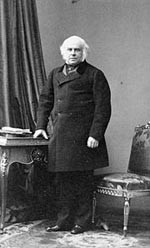James Bruce Elgin was born in London on 20 July 1811, the youngest son of Thomas, seventh Earl of Elgin and his second wife, Elizabeth, the daughter of J. T. Oswald. He completed his studies at Eton and Christ Church, Oxford (BA, 1833; MA, 1835).
In 1840, following the death of his elder brother, he became the heir to the earldom and in 1841, on the death of his father, succeeded to the title, becoming the eighth earl of Elgin. That same year he was elected Southampton's representative in the House of Commons, but his new earldom brought an end to his parliamentary career. In 1842, he accepted the nomination for governor of Jamaica.
He remained in this post until 1847. His successful administration led to him being offered the role of governor general in British North America, which he fulfilled between 1847 and 1854. During his time there, Elgin took the first steps in establishing a “responsible government” in Canada.
In 1848, the moderate reformist parties from Canada East and Canada West, led by Louis-Hippolyte Lafontaine and Robert Baldwin, succeeded in obtaining a majority over the conservatives. Lord Elgin requested that these two parties form a coalition government. After the formation of this new government, Lord Elgin became the first governor to distance himself from legislative affairs, leaving the real power of government to the elected representatives of the people and paving the way for the Canadian general governorship's essentially symbolic role today. He signed a number of laws that had been proposed by Lafontaine and voted on in parliament which abolished the seigniorial system in Canada East and which offered amnesty to the heads of the Canada East “Patriote” movement (following the Patriots' War) who had been sent into exile.
This latter law project was dismissed by Canada East loyalists who protested angrily and set fire to the parliament in Montreal. In 1854, Lord Elgin negotiated the Reciprocity Treaty with the United States in an attempt to stimulate the Canadian economy.
In 1857, he become High Commissioner to China. Visiting China and Japan in 1858 and 1859, he oversaw the end of the Second Opium War and ordered the destruction of the Summer Palace (the ruling Qing dynasty's residence and seat of government), near Peking (today Beijing).
He subsequently became postmaster-general in the Palmerston cabinet and in 1862 was made viceroy of India. He died in Dhurmsala on 20 November, 1863, while still in office.
Source: W. Stewart Wallace, ed., The Encyclopedia of Canada, Vol. II, Toronto, University Associates of Canada, 1948, 411p., pp. 285-286.


